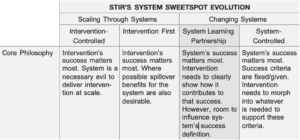(by Sharath Jeevan with Reinier Terwindt, James Townsend & Nithya Gurukumar – STIR Education, with thanks to 17 leading funding and operating organizations who contributed to this piece).
Over the past six and half years since STIR was founded, it feels like we have been grappling with where we best fit within systems. We’re an international NGO that supports governments to re-ignite intrinsic motivation in teachers and local officials, through teacher networks. We are currently working with 200,000 teachers and 6 million children across Uganda and four states in India.
With the benefit of hindsight, we’ve actually tried four different system sweetspots (see table below) – each requiring its own culture, operating model, measurement and sustainability approach. We’re now feeling settled and comfortable in the System Learning Partnerships sweetspot. And we’re learning that occupying this sweetspot requires adhering to two core principles:

1. We need fertile motivational soil in systems – as much as we need technical seeds – to grow the solid oaks of system reform.
There are now great technical interventions out there in our space. But much of the new systems research in education shows that demotivated teachers and local officials often fail to internalize, and sometimes actively resist, strong technical interventions. We need to spend as much time generating the demand for technical interventions – through intrinsic motivation – as we do getting them ever more perfect. And only then can multiple technical interventions flourish together in a given system, so we make a real sustainable dent. That’s a unique contribution we hope to make to systems.
2. Creating Genuine System Learning Partnerships is enormously demanding in culture.
Genuine system learning partnerships need to meet what we call the “Chai test”. Can we sit down over a cup of chai (tea) with leading officials and have an honest conversation? Particularly about system conditions – we’ve learned that our approach is highly sensitive to four key ones. We’ve developed a system diagnostic tool to help diagnose these upfront, and then work with governments and donors to improve them over time. That’s a second, structural contribution to systems we hope to make.
We hope our learning journey within systems saves others similar pain. There is no “right” system sweetspot, of course – we would just suggest that every organization needs to think carefully and candidly about what system sweetspot they really want to occupy. And once they are clear, they align everything in their operating model around that – particularly their organization values and culture.
Contact: Sharath Jeevan sjeevan@stireducation.org



